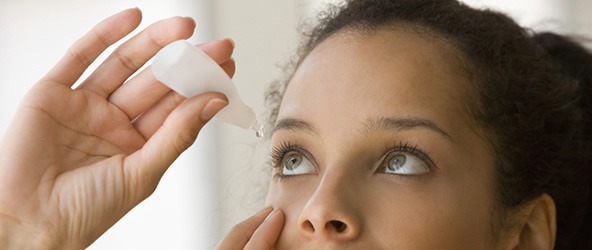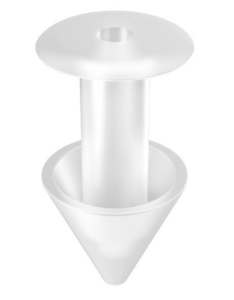Dry Eye Syndrome and Blepharitis
Dry Eye syndrome
Dry eye can range from mild and annoying, to severe and vision threatening. It is not only uncomfortable, it can cause permanent damage to the eye. Even when not severe, dry eye can have a significant impact on quality of life. We believe it is a condition that is often not given enough attention.
We treat dry eye in an individual and tailored approach, depending upon patient symptoms and wishes. Treatment may be conservative and stepwise, or in severe cases, a much more aggressive approach is used. In more severe cases, a medical workup coordinated with the patient’s primary care doctor may be indicated to look for associated or underlying systemic conditions. Regardless of the cause of the dry eye, we can almost always find a regimen that will greatly improve symptoms and dryness of the eye.
Dry eye is a treatable problem, and regardless of the cause, we can almost always find a way to significantly improve the symptoms of our patients.

Who is at risk for Dry Eye?
What are the symptoms of Dry Eye?
Dry Eye Treatment
Dry eye can be treated in many ways. We usually use a combination of therapies, tailored to the needs and lifestyle of each patient. If your symptoms are not adequately relieved, please let us know as there is always more we can do. Below is a partial list of treatments that may be recommended for dry eye.
Artificial tears are the mainstay of dry eye treatment. Tears with preservatives can be used up to 4 times per day; more than this can lead to irritation from the preservative in the tears. Preservative-free tears (these are labeled “preservative-free”) can be used as often as needed. If you need artificial tears 4 or more times per day to control your dry eye symptoms, other treatments should be considered as well. Artificial tears are available over the counter without a prescription. Some good brands include Refresh, Optive, Systane, Theratears, and Blink, among others. Refresh Mega 3 is an excellent preservative free artificial tear that also contains flax seed oil. Artificial tears can be costly, but pricing is better at places like Costco or Amazon.
Moisturizing gel or ointment (Genteal gel, Systane gel, Refresh PM ointment, Lacrilube PF ointment, or generic lubricating ointment — these come in a small tube and not a bottle) are helpful in more severe dry eye or those who feel most dry overnight or upon waking. These products can blur vision temporarily (ointments much more than gel), so unless your eyes are severely irritated/dry, these are usually used before bed rather than throughout the day. Gently lower the lower lid and squirt a line of gel or ointment in across the inside of the lid (onto the surface of the eye if possible). If this blurs your vision too much, use less on the next application.
Warm Compresses can be very soothing, especially first thing in the morning and at the end of the day. We recommend microwavable eye masks (available in our office or online). Place the mask on a paper towel in the microwave for 15-25 seconds and then place over closed eyes for 5-10 minutes once or twice a day. This warms the oils in the glands along the lid rim, allowing the glands to drain more efficiently and preventing inflammation of the glands. This also increases flow of oil from the glands onto the tear film. These oils form the top layer of the tear film and are essential for preventing evaporation of tears.
Omega-3-Fatty-Acid Supplements have been shown to be very helpful in treating dry eyes. We carry an omega 3 fatty acid formula in our office that is designed for good absorption and bioavailability. If you wish instead to purchase online, please purchase either Nordic Naturals or Theratears Nutrition brand– these similarly have good bioavailability while other fish oils may not be as well absorbed. We typically recommend 1000mg (1g)of omega 3 fatty acids 2-3 times per day. As with any nutritional supplement, please check with your primary care doctor before starting this regimen. Omega-3-fatty acid supplements can increase bleeding tendency and need to be stopped before any surgery. If you are already on a blood thinner (apart from aspirin) or have a bleeding tendency, please check with your pcp before starting omega 3 fatty acid supplementation. Start with 1 gram per day and gradually work up to 2-3 grams per day (as starting 3 grams per day all at once can cause diarrhea). It takes about 1 month to see the beneficial effects on dry eye.
Note: there is a 2018 study that questioned the benefit of fish oil in treating dry eye– this study is very controversial and was poorly controlled. Most specialists who treat dry eye still believe omega 3 fatty acids play a key role in treatment. For those who prefer not to take fish oil, flaxseed oil in the same dose is an alternative. Barleans is a good brand.
Lifestyle Modification: In addition to the humidifier on your home heating system, consider a small, portable, desktop humidifier that can easily be moved to suit your activity (desk, nightstand, office, etc.). Adding humidity to the area in which you read or do computer work can help a lot with dry eye. Position your computer so that you are looking somewhat downward at the screen. The more open your lids are (i.e. when looking upward), the faster your tear film evaporates. When outdoors, consider wearing sunglasses with a wrap-around style to block some of the air current that dries the eyes. Make sure that the air vents in your car or work space are not aimed toward your face. Consider using only the lower vents, aimed away from you. Avoid sitting near a fan or vent as these can be very drying.
Medication for Dry Eye: Vevye drops, Restasis Drops, Cequa drops or Xiidra drops: are very helpful in the longer term treatment of dry eye. Dry eye is an inflammatory condition and Vevye, Restasis, Cequa and Xiidra are different types of non-steroid anti-inflammatory medication that do not have measurable systemic absorption (and therefore long-term use is felt to be safe and without known systemic risks). Each of these medications is taken twice a day, morning and evening. These drops may sting when instilled into the eye or a few minutes later (this is normal). Vevye may start to work as soon as 2 weeks after starting, Xiidra and Cequa take 2-6 weeks, and Restasis takes one to six months to reach full effect. Vevye, Restasis, Cequa and Xiidra are each anti-inflammatory medications that help your own eye produce more tears. They also slow the progression of dry eye which tends to get worse over the years as we age. Generally Restasis, Cequa OR Xiidra is prescribed, but occasionally they are used together in severe dry eye cases
Depending upon insurance coverage, the above dry eye medications can be costly. We also work with a national mail order compounding pharmacy to provide a compounded drop very similar to Restasis. Always let us know if a drug we prescribe is expensive as we will try to provide an alternative or work with your insurance company to apply for a prior authorization to reduce the cost.
Punctal Plugs allow more of your own natural tears to stay in your eyes longer. There is a tiny drain in both the upper and lower lid that drains tears out of the eyes and int o the nose. A punctal plug is a tiny silicone plug that is inserted into the little drain on the upper and/or lower lids, trapping more of the naturally produced tears on the eye. Placing the plugs takes about 5 seconds in the office and is painless. The plugs can stay in for years and are usually not felt at all. Some patients experience a slight foreign body sensation or tearing after plug placement, both of which are usually temporary. If these complaints persist, the plugs are easily and painlessly removed in the office, generally in less than 5 seconds. Blowing your nose vigorously or rubbing the inner corner of the eye vigorously can cause the plugs to fall out, so please try to avoid this. Plugs typically have an effect within a day or two, so they are commonly used in combination with Restasis, Cequa or Xiidra which can take up to several months to work. You may notice that the drug information insert on the Restasis package indicates that Restasis did not show benefit in patients who had punctal plugs — this is because Restasis was not studied in combination with punctal plugs in the original FDA trial. Punctal plugs and Restasis, Cequa or Xiidra are commonly used together and are known to be very effective in combination.
o the nose. A punctal plug is a tiny silicone plug that is inserted into the little drain on the upper and/or lower lids, trapping more of the naturally produced tears on the eye. Placing the plugs takes about 5 seconds in the office and is painless. The plugs can stay in for years and are usually not felt at all. Some patients experience a slight foreign body sensation or tearing after plug placement, both of which are usually temporary. If these complaints persist, the plugs are easily and painlessly removed in the office, generally in less than 5 seconds. Blowing your nose vigorously or rubbing the inner corner of the eye vigorously can cause the plugs to fall out, so please try to avoid this. Plugs typically have an effect within a day or two, so they are commonly used in combination with Restasis, Cequa or Xiidra which can take up to several months to work. You may notice that the drug information insert on the Restasis package indicates that Restasis did not show benefit in patients who had punctal plugs — this is because Restasis was not studied in combination with punctal plugs in the original FDA trial. Punctal plugs and Restasis, Cequa or Xiidra are commonly used together and are known to be very effective in combination.
Lacriserts are small, gel-like, soft, capsules that are placed inside the lower lid between the lower lid and the eye, at the outer aspect of the lower lid. The capsules slowly dissolve, for a gradual release of lubrication for up to 12 hours. Lacriserts are available by prescription only. They do require some dexterity to put in place and are not tolerated by all patients.
Oral medications that affect the quality of tears. These act by changing the consistency of the oils that are produced along the lid rim and make up the tear film. These include very low dose doxycycline, minocycline or tetracycline, typically used for at least 3 months.
Autologous serum tears: in very severe dry eye, artificial tears can be made from a patient’s own serum. The patient is sent to a lab for a standard blood draw like one might have for blood testing. The red blood cells are then removed in the lab, leaving behind just the clear serum from the blood that contains growth factors and other substances that promote healing of the surface of the eye. The serum is then mixed with preservative free saline solution to create artificial tears.
Albumin drops: these can be specially compounded by a local specialty pharmacy and can help heal the surface of the dry eye.
Vitamin D deficiency which is more common in places like Chicago, has been associated with increased risk of dry eye symptoms. Your primary care doctor can check your vitamin D level, and if low, may recommend supplementation.
Blephex and Lipiflow are in-office treatments for blepharitis. Blepharitis is the inflammation of the oil glands along the lid rim that plays a major role in causing dry eye. These glands produce oils that contribute to the tear film and prevent its evaporation. If the glands are inflamed, they produce inflammatory oils that inflame the eye and lid rims, and cause redness and dryness of the eyes.
Blephex and Lipiflow are some of the most effective treatment for blepharitis. They are performed in the office and are painless. Blephex provides a gentle exfoliation and cleaning of the lid rims, performed by our trained staff. Lipiflow is a treatment device that fits over the upper and lower lids. The treatment is very relaxing and soothing. It gently warms the lids and and provides a gentle massage to drain the oil glands and decrease inflammation, redness, burning and the risk of styes. It can be very effective in treating dry eye symptoms. Effects of Lipiflow generally last 12-18 months.
This list is not exhaustive, but designed to give you an overview of some of the options we can consider in treating dry eye patients. Treatment recommendations depend on the severity of the dry eye, any associated conditions, patient preference, etc.
Please call our office at (847) 497-2020 for more information of if you would like to schedule an appointment.
For more information, visit the following websites:
Blepharitis
Blepharitis is a very common inflammatory condition involving the oil glands along the eyelid rim. It tends to get worse with age. Inflammation of these glands and production of abnormal oils from the glands can lead to redness, itching, burning, and flaking along the lid rim. In addition, the eye itself can become red, irritated, and dry because the abnormal oils promote inflammation of the eye. Styes or chalazia (inflamed bumps along the eyelids) can result from inflammation of the lid rim oil glands. Eventually, if left untreated, there can be permanent scarring of the oil glands that leads to more severe dry eye that is difficult to treat. The lids and the eyes can become chronically red and uncomfortable.
Blepharitis is a major contributor to dry eye symptoms. In more than half of patients with dry eye complaints, blepharitis is the primary problem. This is because the oils produced by the tiny oil glands along the lid rim form the top coating of the tear film. These oils keep the tear film from evaporating. Even if your eye produces enough of the watery part of the tear film, a lack of the oily top layer will allow tears to evaporate quickly and the eye becomes very dry and uncomfortable.
Blepharitis is a chronic condition (very similar to rosacea), that we control rather than cure. We have many ways of treating this condition, and we tailor our approach to the individual patient. Various treatment options are outlined below to provide an overview.
What are the symptoms of blepharitis?
Common symptoms include:
- Itching or scratchy eyes
- Foreign body sensation
- Tearing
- Crusting
- Redness/Inflammation of eyes and eyelids
- Discharge
- Dry eye
- Flaking of the lid rims
- Styes or chalazia (red bumps on the lid rim)
In more serious cases of blepharitis, however, permanent scarring of the lid rims and cornea can occur, which can lead to vision loss.
Blepharitis Treatment
Lids scrubs: These are a key maintenance treatment for blepharitis. The goal is to use a very gentle detergent to clean along the eyelid rim at the base of the lashes. This can be done using specially formulated cleanser (Tea Tree Oil Foaming Lid Cleanser which is available in our office or online), or using lid scrub pads (Ocusoft, Systane or generic brand eyelid scrubs). The affected oil glands are just behind the lash line on the lid rim. Be sure to handle the lid tissue gently as pulling down on the lower lid aggressively repeatedly over time can lead to laxity of the lower lid. Gently scrub the lid rim (not the inside of the eyelid) along the base of the lashes. Then close the eye and wash along the upper lash line as close to the base of the lashes as possible. Keeping the eyes closed, rinse away the detergent with warm water. Tea Tree Oil (in eyelid cleanser or lid scrub pads) has been shown to be very effective against the specific organisms (Demodex mites) that often promote blepharitis. This is a very gentle product and can be used twice a day.
Warm Compresses can be very soothing, especially first thing in the morning and at the end of the day. We recommend microwavable eye masks (available in our office or online). Place the mask on a paper towel in the microwave for 15-25 seconds until warm (but not hot enough to be uncomfortable) and then place over closed eyes for 5-10 minutes once or twice a day. This warms the oils in the glands along the lid rim, allowing the glands to drain more efficiently and preventing inflammation of the glands.
Oral Omega-3-Fatty-Acid Supplements are controversial. Many who treat dry eye and blepharitis believe they are helpful. Several recent studies have not been able to show any benefit. Nonetheless, some people do seem to respond with improved symptoms when taking omega-3-fatty acid supplements. We carry an omega 3 fatty acid formula in our office that is designed for good absorption and bioavailability. If you wish instead to purchase online, please purchase either Nordic Naturals or Theratears Nutrition brand– these similarly have good bioavailability while other fish oils may not be as well absorbed. We typically recommend 1 capsule of omega 3 fatty acids 2-3 times per day. As with any nutritional supplement, please check with your primary care doctor before starting this regimen. Omega-3-fatty acid supplements can increase bleeding tendency and need to be stopped before any surgery. In addition, if you take a blood thinner (other than aspirin), or have a bleeding tendency, please check with your pcp before starting omega 3 fatty acid supplementation. Start with 1 capsule per day and gradually work up to 2-3 capsules per day (starting with 3 capsules per day all at once can cause diarrhea). It takes about 1 month to see the beneficial effects on dry eye and blepharitis.
Azasite Drops: While Azasite is an antibiotic effective against the bacteria along the lid rim, it has an even more important anti-inflammatory effect on the lid rim oil glands. Please store the Azasite at room temperature, upside down (with the cap down so the very thick drops are easier to get out of the bottle). Use these drops twice per day for the first 3 days, then once per day for one month. If your blepharitis is severe/persistent, longer term use may be recommended. In this case, after the first month of use, switch to every other day and you can stay on this regimen long term. While this medication can be helpful, it is very costly, so we tend not to use it as much.
Oral doxycycline or minocycline: While these medications are antibiotics, the more important benefit for blepharitis and dry eyes are their anti-inflammatory effects on the oil glands along the lid rim. We often prescribe a three month course of medication, but low doses can also be used long-term. These drugs make oral contraceptives less effective. They should not be taken by pregnant women, those who could become pregnant while on the medication, and those who are nursing as they can cause birth defects and harm very young children. Skin can become more sensitive to sun while on doxycycline, so good sun protection is important. There are also rare hematologic side effects.
Blephex and Lipiflow are some of the most effective treatments for blepharitis. They are painless lid treatments performed in our office by specially trained staff. Blephex provides a gentle exfoliation and cleaning of the lid rims, removing inflammatory debris, dead skin cells, and allowing the oil glands to function better. Lipiflow is a treatment device that fits over the upper and lower lids. The treatment is very relaxing and soothing. It gently warms the lids and and provides a gentle massage to drain the oil glands and decrease inflammation, redness, burning and the risk of styes. Both of these treatments can be very effective in treating dry eye symptoms. Effects of Lipiflow generally last 12-18 months, but with a proper maintenance regimen, can last longer. Please click below to learn more about Blephex and Lipiflow.
Xdemvy (Lotilaner 0.25%) eye drops: This is an eye drop that lingers on the lid rim after being instilled in the eye. It is typically prescribed for a 6 week course (not usually long term), twice a day. It is extremely effective in treating blepharitis that is primarily related to Demodex. Please click here for more information on blepharitis and Demodex.
As with our approach to dry eye patients, we believe in a treatment plan tailored to the needs and wishes of the patient, often involving a combination of therapies for the best result. Please call our office at (847) 497-2020 if you would like to schedule an appointment.
For more information, visit the following websites:
For more detailed information on other eye conditions treated by our practice, please select a topic below:

